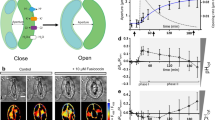“You can observe a lot by watching” Lawrence Berra, as quoted in “Sports Illustrated”, vol. 60 (No. 14), p. 94, 2 April 1984
Abstract
Lucifer yellow has been microinjected into stomatal cells of Allium cepa L. epidermal slices and Commelina communis L. epidermal peels and the symplastic spread of dye to neighboring cells monitored by fluorescence microscopy. Dye does not move out of injected mature guard cells, nor does it spread into the guard cells when adjacent epidermal or subsidiary cells are injected. Dye does spread from injected subsidiary cells to other subsidiary cells. These results are consistent with the reported absence of plasmodesmata in the walls of mature guard cells. Microinjection was also used to ascertain when dye coupling ceases during stomatal differentiation in Allium. Dye rapidly moves into and out of guard mother cells and young guard cells. Hovewer, dye movement ceases midway through development as the guard cells begin to swell but well before a pore first opens. Since plasmodesmata are still present at this stage, the loss of symplastic transport may result from changes in these structures well in advance of their actual disappearance from the guard cell wall.
Similar content being viewed by others
Abbreviations
- DIC:
-
differential interference contrast
- GMC:
-
guard mother cell
- LY:
-
Lucifer yellow
- Pd:
-
plasmodesmata
References
Allaway, W.G., Setterfield, G. (1972) Ultrastructural observations of guard cells of Vicia faba and Allium porrum. Can. J. Bot. 50, 1405–1413
Carr, D.J. (1976) Plasmodesmata in growth and development. In: Intercellular communication in plants: studies on plasmodesmata, pp. 243–289, Gunning, B.E.S., Robards, A.W., eds. Springer, Berlin Heidelberg New York
Couot-Gastelier, J., Laffray, D., Louguet, P. (1984) Étude comparée de l'ultrastructure des stomates ouverts et fermés chez le Tradescantia virginiana. Can. J. Bot. 62, 1505–1512
Dauwalder, M., Serlin, B., Roux, S. (1983) Ca45 localization in gravistimulated oat coleoptiles- comparison of antimonate procedures. (Abstr.). J. Cell Biol. 97, 415a
Edwards, A., Bowling, D.J.F. (1984) An electrophysiological study of the stomatal complex of Tradescantia virginiana. J. Exp. Bot. 35, 562–567
Erwee, M.G., Goodwin, P.B. (1984) Characterization of the Egeria densa Planch. leaf symplast. Inhibition of the movement of fluorescent probes by group II ions. Planta 158, 320–328
Erwee, M.G., Goodwin, P.B. (1984) Characterization of the Egeria densa symplast. Response to plasmolysis, deplasmolysis and to aromatic amino acids. Protoplasma 122, 162–168
Goodwin, P.B. (1983) Molecular size limit for movement in the symplast of the Elodea leaf. Planta 157, 124–130
Gunning, B.E.S., Robards, A.W. (1976) Intercellular communication in plants: studies on plasmodesmata. Springer, Berlin Heidelberg New York
MacRobbie, E.A.C. (1981) Ionic relations of stomatal guard cells. In: Stomatal physiology, pp. 51–70, Jarvis, P.G., Mansfield, T.A., eds. Cambridge University Press, Cambridge. UK
Overall, R.L., Gunning, B.E.S. (1982) Intercellular communication in Azolla roots. II. Electrical coupling. Protoplasma 111, 151–160
Palevitz, B.A. (1981) Structure and development of stomatal cells. In: Stomatal physiology, pp. 1–23, Jarvis, P.G., Mansfield, T.A., eds. Cambridge University Press, Cambridge, UK
Palevitz, B.A., Hepler, P.K. (1974) The control of the plane of division during stomatal differentiation in Allium. I. Spindle reoreintation. Chromosoma 46, 297–326
Palevitz, B.A., Hepler, P.K. (1976) Cellulose microfibril orientation and cell shaping in developing guard cells of Allium: the role of microtubules and ion accumulation. Planta 132, 71–93
Palevitz, B.A., O'Kane, D.J., Kobres, R.E., Raikhel, N.V. (1981) The vacuole system in stomatal cells of Allium. Vacuole movements and changes in morphology in differentiating cells as revealed by epifluorescence, video and electron microscopy. Protoplasma 109, 23–55
Schroeder, J.I., Hedrich, R., Fernandez, J.M. (1984) Potassium-selective single channels in guard cell protoplasts of Vicia faba. Nature 312, 361–362
Stewart, W.W. (1981) Lucifer dyes-highly fluorescent dyes for biological tracing. Nature 292, 17–21
Tucker, E.B. (1982) Translocation in the staminal hairs of Setcreasea purpurea. I. A study of cell ultrastructure and cell-to-cell passage of molecular probes. Protoplasma 113, 193–201
Warner, A.E., Guthrie, S.C., Gilula, N.B. (1984) Antibodies to gap-junctional protein selectively disrupt junctional communication in the early amphibian embryo. Nature 311, 127–31
Wille, A.C., Lucas, W.J. (1984) Ultrastructural and histochemical studies on guard cells. Planta 160, 129–142
Willmer, C.M., Sexton, R. (1979) Stomata and plasmodesmata. Protoplasma 100, 113–124
Zeiger, E., Hepler, P.K. (1979) Blue light-induced, intrinsic vacuole fluorescence in onion guard cells. J. Cell Sci. 37, 1–10
Author information
Authors and Affiliations
Rights and permissions
About this article
Cite this article
Palevitz, B.A., Hepler, P.K. Changes in dye coupling of stomatal cells of Allium and Commelina demonstrated by microinjection of Lucifer yellow. Planta 164, 473–479 (1985). https://doi.org/10.1007/BF00395962
Received:
Accepted:
Issue Date:
DOI: https://doi.org/10.1007/BF00395962




